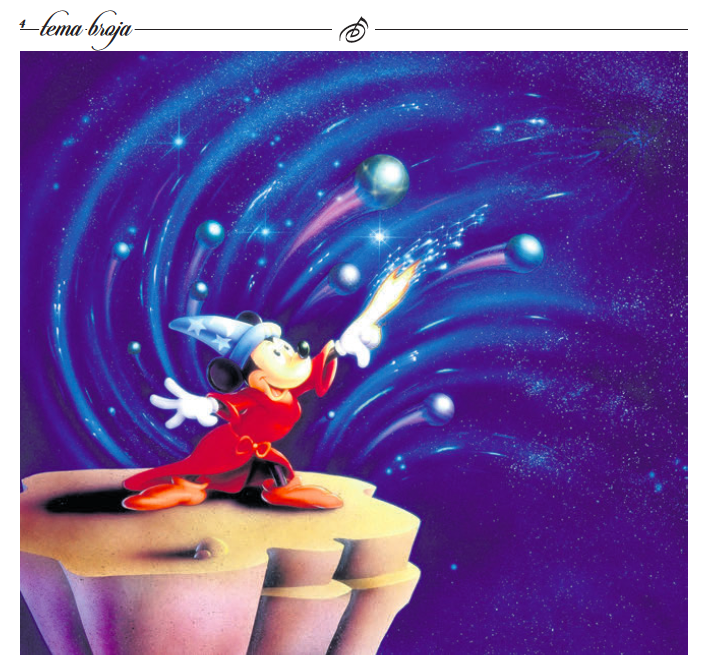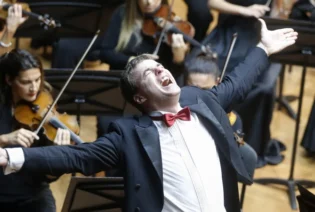
Walt Disney’s Greatest Experiment
Walt Disney had been planning a short animated film that would make Mickey Mouse a star again. Then “Fantasia” happened, which no one had expected.
It was not the first time that his idea had been viewed with wonder and disbelief. On the contrary, there had already been some consistency in this. First, they wondered why a cartoon even needed sound. Then the introduction of color seemed superfluous. And then, in the eyes of the Hollywood press, the production of Snow White and the Seven Dwarfs was proclaimed a “folly” which, it was believed, would probably take its creator down the path of ruin. After all, who in the world would want to watch a cartoon that lasted almost an hour and a half? But, as it turned out, almost everybody! After the premiere in December of 1937, the irresistible dwarfs and the delightful Snow White were adored by children and adults from the avenues of New York City to Belgrade’s Terazije, and the first feature-length animated film became the most widely viewed success in cinema history. Walt Disney was only 36 years old and was on the top of the world, which finally believed in his miracles.
But he was already preparing his next miracle. Neither the unimaginable glory nor the astronomical box office revenues could turn his life’s focus away from elevating animated film to the same pedestal with all the other art forms. Only a decade earlier, his Mickey Mouse had enchanted and delighted the entire planet, bringing the first major recognition to the cartoon, which, in the following years, Disney continued to perfect with his Silly Symphony series, where he set all the action to music so that the image and sound were merged into an inseparable whole. It was these mini-musicals that gave us the legendary Three Pigs and Donald Duck, who, after the debut of The Wise Little Hen in 1934, managed to upstage even the unrivaled Mickey Mouse.
Disney had been thinking for some time about reanimating his mousey alter ego. His attention was drawn to Goethe’s poem The Sorcerer’s Apprentice and the Paul Dukas symphonic poem based on it. So, he decided to use them as the basis for a special animated short film, which, he believed, would bring Mickey back as a leading star. In a Hollywood restaurant, he bumped into Leopold Stokowski, a celebrated conductor and director of the Philadelphia Philharmonic, and told him about his idea. The eccentric Stokowski, a great admirer of Disney’s work, was delighted to take part in the unusual venture without any compensation.
In January of 1938, Stokowski gathered 85 Hollywood musicians and in the wee hours recorded the musical accompaniment. The Sorcerer’s Apprentice had to outdo everything that had been filmed so far, and for that reason Disney hired the best animators in the studio, including Fred Moore, who redesigned Mickey and even added pupils to make him even more expressive. Footage of real actors was used as a reference for Mickey’s movements, the storyboards were done in full color and with lots of details, and the effects technicians studied every aspect of the movement of water in order to convey it as convincingly as possible. When, in mid-1938, the cartoon was almost finished, Mickey and his surroundings never looked so alive.
However, Disney was in a dilemma. Production costs had already tripled the usual sum for a short film, so it was clear to Walt and his brother Roy, who was in charge of financing, that The Sorcerer’s Apprentice had no chance of returning funds invested. Then they came up with the idea of extending the work and recording a hybrid feature-length animated film that would make use of the power of classical music and drawings in a new form of animated concert without dialogue or sound effects. The experimental project was unofficially dubbed “Full-Length Concert” or “Full-Length Musical.”
The Cavalry and Mushrooms Come to the Aid of the Apprentice
The first and most important task was to choose the right music. An unusual group of artists, screenwriters, and producers led by Disney narrowed the selection down to 15 compositions, only to choose six more works in addition to The Sorcerer’s Apprentice: Bach’s Toccata and Fugue in D Minor, The Nutcracker Suite by Pyotr Ilyich Tchaikovsky, The Rite of Spring by Igor Stravinsky, Beethoven’s Sixth Symphony, The Dance of the Hours from the opera La Gioconda byAmilcare Ponchielli, a combination of Modest Mussorgsky’s tone poem Night on Bald Mountain and Franz Schubert’s Ave Maria. Stokowski called the movie Fantasia, using a professional expression signifying a free musical form.
Although by the end of 1938, it had brought together top classical music experts, including Deems Taylor, a celebrated commentator from the Metropolitan Opera, Fantasia could not get into full swing because the simultaneous production of Pinocchio and the completion of the new studio in Burbank depleted the studio’s human and financial resources in a big way. “This time, avoid gags and use your imagination for the purposes of Fantasia,” Disney told his cartoonists and animators, encouraging them to experiment with styles and study the techniques of the Renaissance painters in order to present the music visually. At the same time, unhappy with contemporary sound systems, he hired his best experts to design a new system that would be able to play orchestra music at a higher quality level.
As preparations moved along, Disney was increasingly looking at Fantasia as an opportunity for a new revolution in the field of animation, which is why he gradually lost his enthusiasm for Pinocchio. In the second half of 1938, the meetings to discuss stories, layouts, and other aspects of the experimental film became more frequent, and shorthand minutes from those meetings helped sequence directors and animators adhere to Disney’s instructions. Over 60 sketch artists from the special effects department were engaged to create hypnogogic images for the introductory sequence with Bach’s music. In order to find the inspiration to illustrate at such an abstract level, the animators sought inspiration from the works of German director Oskar Fischinger and executed hundreds of pastel studies to emphasize the melodic plane of Bach’s work with simple geometric shapes.
In 1939, production was going full steam ahead. The team in charge of The Nutcracker Suite released the composition’s first two movements, rearranging the others so as to best set the changing seasons to sound. When he saw the first drawings of the mushrooms, Disney saw the opportunity for an interesting animation in the Chinese Dance – he got the idea to insert an ungainly mushroom and thus add additional dynamics. After dozens of different sketches, the mushrooms got their final appearance and the main animation baton was passed on to Art Babbitt, the experienced creator of Goofy.
The Rite of Spring, a melodic ballet by Igor Stravinsky, written just a few years earlier, was used for the epic saga of the origin of life on Earth. In the studio, biologists, paleontologists and astronomers were invited to contribute as convincingly as possible, while in the Special Effects Department experimented with flammable materials in order to better depict smoke, lava and celestial bodies. However, Stravinsky did not like the way Disney adapted his music in the film, although during the production he did visit the studio and watch the prepared storyboards. Presumably, the composer did not mind the sequence concept but the fact that Stokowski had rearranged the orchestration without his permission.
Originally, instead of Beethoven’s Pastoral Symphony, Disney wanted to use the music by “a French composer,” which he felt would be more suitable for the brighter content he had planned, but ultimately, despite Stokowski’s opinion, he opted for Beethoven. The animation of this segment was entrusted to star animators Fred Moore and Ward Kimball, while Otto Englander, the only Yugoslav on Disney’s team, headed the story development team. The moment when the group of winged horses swoops down to the lake surface, depicts the synergistic beauty of animation and classical music so convincingly. Thirty years later, the parts that reflected the racial stereotypes of the interwar period, such as a black Centaur polishing the hoof of a white one, were taken out of the sequence.
The Dance of the Hours sequence, undoubtedly the most comical in Fantasia, was remembered by generations growing up with cartoons on Belgrade Television. Walt Disney imagined it as a parody of classical ballet with hippos, ostriches, elephants and crocodiles. In an effort to make the movements on paper as convincing as possible, the animators spent months observing professional dancers Marge Champion and Irina Baronova. They also used clay figures made by the Disney Studio’s modeling department, to facilitate the drawing of characters in different poses.
The last segment of the film in its stylized form evokes the conflict of good and evil using the works of Mussorgsky and Schubert. In this case, the animators had a somewhat easier task since they relied entirely on the detailed storyboards of Kay Nielsen, one of the most respected illustrators from the early 20th century. The special effects are remarkable, and the way Bill Tytla brought to life the image of the Slavic deity Chernobog is remembered as one of the greatest achievements in the history of the genre. At one point Disney even though of releasing the smell of incense into the cinema during the Ave Maria, but abandoned the idea for practical reasons. Fantasia ends with the sunrise, a symbol of hope, which was so needed by the world, teetering on the brink of war.
In the meantime, Disney’s engineers patented “Fantasound,” an innovative sound reproduction system. For the first time in movie history, music was recorded in some form of stereo format and the 33 speaker system gave the impression of the symphony orchestra being in the cinema hall. In the last stage of the work, over 1,000 artists and technicians were engaged around the clock in coloring and recording the finished celluloid films. After three intense years, the film was completed only 48 hours before its scheduled premiere.
The Success That (Had Not) Happened
Just as a rainstorm on that November 13, 1940 passed over New York City, Fantasia was premiered at a gala dinner in a theater on Broadway. The nervous Disney personally visited the hall the previous day to check once more that everything was ready for the big event. The most prominent New York officials were greeted and ushered to their seats, and each was given a specially designed program, as if it were a new opera or concert. The screening ended with ovations.
Disney believed that Fantasia would impress the audience in the same way that Snow White had, but he was wrong. The Fantasound system was so expensive that it was purchased only by 14 cinemas in the United States, and when the ordinary version of the film with “inferior” sound was released a few months later, the disinterested American audience delivered him an unexpected blow. The RKO distributor insisted that Fantasia should be reduced from 125 to 82 minutes in order to show “two films for the price of one,” Disney had to agree, but did not want to take part in the repacking. Although it appeared successfully for months in New York, Los Angeles and San Francisco, Fantasia was withdrawn from distribution at the end of 1942 and in many places was never included in the program again.
The timing could not have been worse due to the outbreak of World War II in Europe, the market that had brought half of all revenues to the studio. Since Pinocchio, which was premiered before Fantasia, failed to return the money invested in it, Disney had to discard the already designed sequences for Fantasia 2 and the ambitious idea of Fantasia becoming a special program shown every few years, with a different content and sequence of scenes.
As expected, the reviews were exceptional. The New York Times said that Fantasia was a “historical moment in the development of motion pictures,” while Art Digest Magazine called it an “unforgettable aesthetic experience.” The Chicago Tribune, which had had assigned three writers to cover the film’s Chicago premiere – a society columnist, a film critic, and a music critic, said the film was “bewildering” and Stokowski appeared on the cover page of the December 1940 issue of Time Magazine.
It is hard to imagine what the art of animation would look like today if by some chance Fantasia had been as successful as Snow White and the Seven Dwarfs; the movie was so badly received by audiences that it took three decades to recover the total recording costs of today’s sum of $38 million. “I did not regret recording it. We had to do something like that for the media at that moment,” Disney said later. Ironically, Fantasia became a hit with audiences after the war – including Yugoslavia – and gained a well-deserved cult status.
When asked in a conversation in 1940 to comment on the work on Fantasia, Disney replied in his jovial style: “Bach and Beethoven may be unusual company for Mickey Mouse, but it was a lot of fun.”
Even 80 years later, there is nothing unusual about spending a Sunday evening in June at Belgrade’s Ušće grounds in the company of Fantasia.
Marko Jeličić
Published in the eight issue of the Filharmonija Magazine, which is printed as a supplement in the Srpski Telegraf







